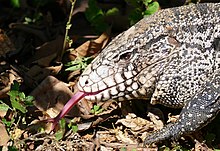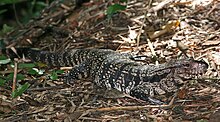| Argentine black and white tegu | |
|---|---|

| |
| Male | |

| |
| Female | |
| Scientific classification | |
| Domain: | Eukaryota |
| Kingdom: | Animalia |
| Phylum: | Chordata |
| Class: | Reptilia |
| Order: | Squamata |
| Family: | Teiidae |
| Genus: | Salvator |
| Species: | S. merianae
|
| Binomial name | |
| Salvator merianae | |

| |
| Synonyms[4] | |
| |
The Argentine black and white tegu (Salvator merianae), also known as the Argentine giant tegu, the black and white tegu, or the huge tegu,[1] is a species of lizard in the family Teiidae. The species is the largest of the "tegu lizards".[5] It is an omnivorous species which inhabits the tropical rain forests, savannas and semi-deserts of eastern and central South America. They are native to southeastern Brazil, Uruguay, eastern Paraguay, and Argentina.[6]
Tegus are sometimes kept as pets by humans. They are notable for their unusually high intelligence and can also be housebroken. Like other reptiles, tegus go into brumation in autumn when the temperature drops. They exhibit a high level of activity during their wakeful period of the year. They are the only known extant non-avian reptiles to be partly endothermic.
Tegus fill ecological niches similar to those of monitor lizards, but are only distantly related to them; the similarities are an example of convergent evolution.
- ^ a b Scott, N.; Pelegrin, N.; Montero, R.; Kacoliris, F.; Fitzgerald, L.; Carreira, S.; Cacciali, P.; Moravec, J.; Cisneros-Heredia, D.F.; Aparicio, J.; Avila-Pires, T.C.S. (2016). "Salvator merianae". IUCN Red List of Threatened Species. 2016: e.T178340A61322552. doi:10.2305/IUCN.UK.2016-1.RLTS.T178340A61322552.en. Retrieved 5 November 2021.
- ^ "Appendices | CITES". cites.org. Retrieved 2022-01-14.
- ^ Cite error: The named reference
Dumeril et al., 1839was invoked but never defined (see the help page). - ^ "Tupinambis merianae". www.reptile-database.org. The Reptile Database.
- ^ "Wild Herps - Argentine Giant Tegu (Salvator merianae)". www.wildherps.com.
- ^ Wood, Jared P.; Beer, Stephanie Dowell; Campbell, Todd S.; Page, Robert B. (December 2018). "Insights into the introduction history and population genetic dynamics of the Argentine black-and-white tegu (Salvator merianae) in Florida". Genetica. 146 (6): 443–459. doi:10.1007/s10709-018-0040-0. ISSN 0016-6707. PMID 30244302.
